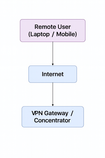Building a Scalable BGP Design with Route Reflectors and Confederations
- The Itvue Team
- Aug 9
- 3 min read
Updated: Aug 15
Author Ermias Teffera

Overview
In today’s growing multi-AS enterprise environments, designing a scalable and manageable BGP topology is crucial. This post walks through a BGP topology using Route Reflectors (RRs) and Confederations as seen in the sample network diagram above, focusing on devices R5 and R6 as RRs, and highlighting the segmentation via Confederations (AS 64513 and 64514). This architecture is implemented by ITVue Networks.
AS Topology Summary
Core AS: 500 (ITVue Networks Core)
Confederate Sub-ASes:
AS 64513 (Left sub-AS: R1, R3, R5)
AS 64514 (Right sub-AS: R2, R4, R6)
External Connections:
ISP-1: R1 to R7 via 216.185.3.2/30 (AS 200)
ISP-2: R2 to R8 via 198.1.51.2/30 (AS 100)
Customer: R9 to CUST-1 (AS 64512) via 150.0.0.0/24
Route Reflector (RR) Design
In a full mesh iBGP setup, each iBGP peer must connect to every other peer within the AS. This becomes unwieldy as the number of routers grows. To solve this, Route Reflectors are used.
R5 and R6 as Route Reflectors:
R5 and R6 are configured as RRs with Cluster ID: 1.
Clients of R5: R1, R3
Clients of R6: R2, R4
RR-to-RR Peering: Established over 10.1.0.48/30 between R5 (.49) and R6 (.50)
This minimizes the iBGP mesh to:
Client-to-RR sessions only
RR-to-RR session between R5 and R6
iBGP Sessions:
R1 to R5 over 10.1.0.38
R3 to R5 over 10.1.0.45
R2 to R6 over 10.1.0.29
R4 to R6 over 10.1.0.26
Sample BGP Configurations
R5 (Route Reflector for AS 64513)
router bgp 64513
bgp router-id 5.5.5.5
bgp cluster-id 1
bgp log-neighbor-changes
neighbor 10.1.0.38 remote-as 64513
neighbor 10.1.0.38 route-reflector-client
neighbor 10.1.0.45 remote-as 64513
neighbor 10.1.0.45 route-reflector-client
neighbor 10.1.0.49 remote-as 64514
R6 (Route Reflector for AS 64514)
router bgp 64514
bgp router-id 6.6.6.6
bgp cluster-id 1
bgp log-neighbor-changes
neighbor 10.1.0.29 remote-as 64514
neighbor 10.1.0.29 route-reflector-client
neighbor 10.1.0.26 remote-as 64514
neighbor 10.1.0.26 route-reflector-client
neighbor 10.1.0.50 remote-as 64513
R1 (Client in AS 64513)
router bgp 64513
bgp log-neighbor-changes
neighbor 10.1.0.41 remote-as 64513
R2 (Client in AS 64514)
router bgp 64514
bgp log-neighbor-changes
neighbor 10.1.0.30 remote-as 64514
R5 and R6 Confederation Global Settings
router bgp 500
bgp confederation identifier 500
bgp confederation peers 64513 64514
Confederation Setup
To further scale and isolate the network, the large AS 500 is broken into two smaller sub-ASes using BGP Confederation:
R1, R3, R5: part of Confederation AS 64513
R2, R4, R6: part of Confederation AS 64514
Each sub-AS runs full iBGP or RR-based iBGP internally, and uses eBGP-like rules between the sub-ASes (inter-confed).
Confederation Benefits:
Reduces iBGP mesh within sub-AS
Retains route scalability while appearing as a single AS (500) to external peers
Allows policy control between sub-ASes
Key Confederation Links:
R5 (.50) <--> R6 (.49) over 10.1.0.48/30 (confed eBGP between sub-ASes)
R3 (.9) to R9 (.2) over 150.1.0.0/30 (confed eBGP to customer)
Peering with External Networks
R1 peers with ISP-1 (R7) using 216.185.3.2
R2 peers with ISP-2 (R8) using 198.1.51.2
R9 (internal edge router) peers with CUST-1 AS 64512 over 150.0.0.0/24
All external sessions are true eBGP.
Summary
This BGP topology demonstrates:
Efficient scaling with Route Reflectors (R5, R6)
Controlled segmentation via Confederations (AS 64513 & 64514)
Clean external peering using eBGP
The architecture ensures scalability, reduced complexity, and efficient policy control for large networks. Ideal for enterprise, cloud, or ISP-grade BGP designs — and proudly implemented by ITVue Networks.










Great job, Ermias! You’ve done an excellent job distilling complex BGP design principles into an accessible overview—especially the use of Route Reflectors (RRs) and Confederations for scalable iBGP deployment.
I appreciate how you laid out the core rationale: RRs dramatically reduce the full-mesh mandates of iBGP, simplifying peering configurations and easing CPU and memory overhead on routers. Your choice of R5 and R6 as reflectors in a multi‑AS enterprise context makes the design both intelligible and practical.
Breaking the topology into Confederations (AS 64513 and 64514) adds an elegant layer of hierarchical scale. As you rightly point out, Confederations shrink peering complexity within sub‑AS domains—while preserving policy control and routing visibility to the wider network.
To deepen the discussion, you might…
I’m not from a technical background, but Ermias Teffera’s clear and insightful explanation of scalable BGP design really stood out. If you’re looking for someone who can simplify complex networking challenges and deliver real solutions, I highly recommend reaching out to Ermias for your next project.
Fitsum Habtemariam, Project Manager